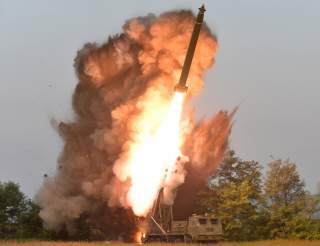California Should Be Very Worried About War With North Korea (And For Good Reason)
The U.S. West Coast is in range of Kim's nuclear missiles.
Key point: Hundreds of thousands of Americans would die.
The recent revelation that North Korea has intercontinental ballistic missiles put America on notice: within a few short years, or even months, the entire continental United States will be within range of Pyongyang’s nuclear weapons. While practical counterforce targets—such as bomber and missile bases—exist, there is also an argument to be made that Kim Jong-un would target major American cities to inflict maximum damage. One of those cities would almost certainly be San Francisco.
San Francisco is often considered one of the most beautiful cities in the world. The city has a population of 864,816 within an area roughly seven by seven miles wide, and is the second largest population concentration in America after New York City. San Francisco is on a peninsula and is at the center of a larger metropolitan area, the San Francisco Bay Area, with a population of approximately seven million.
In a previous article covering an attack on Tokyo, we assumed a North Korean Pukkuksong-2 missile delivering a 20-kiloton warhead would be used—a more or less realistic estimate for an attack over the next twelve months. Given that the Hwasong-15 ICBM is not likely capable of delivering a warhead on San Francisco for up to two years, we’ll assume that North Korea has a few more years to miniaturize a more powerful device. For this scenario, we’ll assume the Hwasong-15 can deliver a 250-kiloton device, as powerful as the 2017 underground test.
Using the NUKEMAP, a web site designed to simulate the effects of nuclear weapons, we can estimate that a 250-kiloton warhead detonated over San Francisco could kill between 88,000 and 321,000 people in the Greater San Francisco Bay Area. Such an attack would further injure another 182,000 to 206,000, and expose millions to radioactive contamination.
On the low end, an attack on the western half of San Francisco could kill as many as 89,050 and injure 178,130. This number is relatively low because much of the weapon effects would spread out over the Pacific Ocean. The western half of San Francisco also largely consists of single family homes and smaller apartment buildings, reducing the overall population density.
On the high end, an attack on downtown San Francisco could kill 269,560 and injure 200,440. Most homes in this area are multi-unit apartment complexes, increasing population density. One issue that could send casualty estimates skyrocketing: during the day, the population of San Francisco swells by 265,000, as people commute into the city for work. These numbers are overwhelmingly concentrated in the downtown and South of Market areas, making a daytime attack particularly lethal.
An attack against the geographic center of the city, somewhere around the Twin Peaks neighborhood, would kill 154,810 and injure 326,340. If North Korea were interested in attacking monuments and not population centers, an attack against the Golden Gate Bridge would probably annihilate the bridge but cause relatively few casualties—the park land and bay surrounding the iconic bridge means few people actually live nearby. As a result, NUKEMAP predicts just 8,000 killed and 143,150 injured.
San Francisco’s geography may mitigate—or enhance—the effects of nuclear weapons. The city’s western half is flat, a legacy of the sand dunes that were paved over to building single family housing, allowing heat and blast waves to roll impeded across entire neighborhoods. The city is also relatively flat from downtown and the Financial District to the Mission District area. However, several large hills straddle the rough geographic center of city, conceivably isolating some blast and thermal radiation effects. A similar geographical setup spared parts of Nagasaki in 1945.
Another factor to consider is the spread of radioactive fallout. Offshore winds will carry radioactive particles inland, in a northeasterly direction. This will spread the effects of the bomb beyond the city into the suburbs, causing radiation sickness and long-term health issues. Dangerous levels of fallout will carry as far north as Sacramento, the state capitol.
In many cases, the fact that San Francisco is located on a peninsula reduces casualty rates. However, in a postattack situation, the location will work against the city. The northern half of the city is directly connected to the rest of the Bay Area by just traffic sixteen lanes on two bridges. This, combined with civilian traffic, will make it difficult to flow emergency services into the city and to evacuate the wounded out. Although the military has trained to land hovercraft on nearby beaches in disaster situations, if the beaches are contaminated by radioactive fallout relief efforts will need to find another route.
These various nuclear attack scenarios are not set in stone: North Korea could use a smaller weapon, or the warhead might fail to work, get shot down by U.S. defenses, or land in the ocean. Still, North Korea is making phenomenal progress in both its nuclear and missile programs, and sooner or later it will have a large, reliable warhead on a reliable, accurate missile. While disturbing, the discussion of casualties should only reinforce the resolve of all sides to avoid the use of nuclear weapons at all costs.
Kyle Mizokami is a defense and national-security writer based in San Francisco who has appeared in the Diplomat, Foreign Policy, War is Boring and the Daily Beast. In 2009 he cofounded the defense and security blog Japan Security Watch. You can follow him on Twitter: @KyleMizokami. This article first appeared last year.
Image: Reuters.

